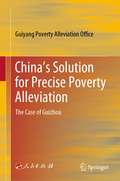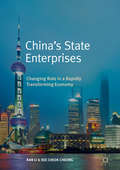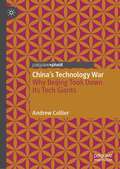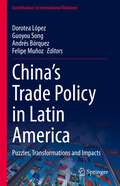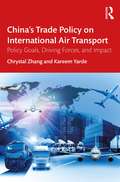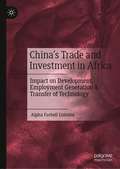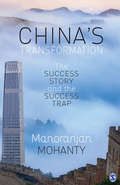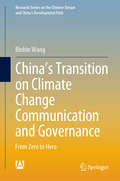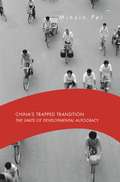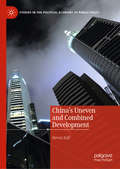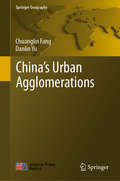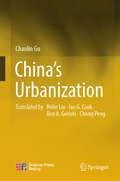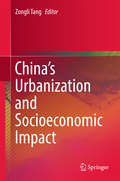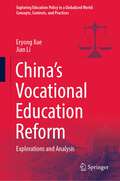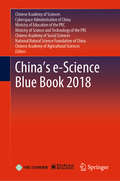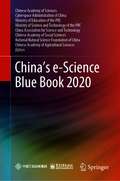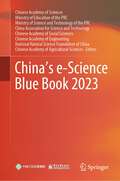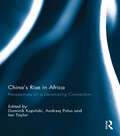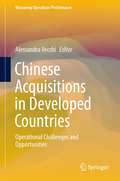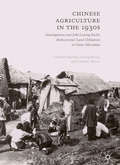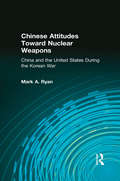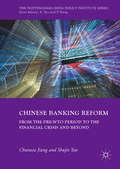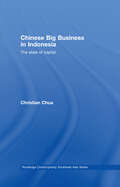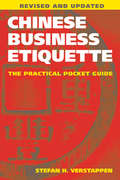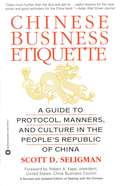- Table View
- List View
China’s Solution for Precise Poverty Alleviation: The Case of Guizhou
by Guiyang Poverty Alleviation OfficeThis book select successful cases of poverty reduction and alleviation in the Guizhou province of China, which reflects the highest number and widest distribution of people living in poverty. The local government seeks to achieve sustainable development goals and find multiple solutions to the problem.. The book introduces local experiences and presents the whole process from policy making to practice.
China’s State Enterprises: Changing Role in a Rapidly Transforming Economy
by Ran Li Kee Cheok CheongThis book focuses on the nature and significance of China’s state enterprises which have undergone substantial changes since China’s economic liberalization in 1978. It argues that much of the criticism is based on mistaken premises, where even the term ‘state-owned enterprises’ is a misnomer given that the emphasis is much less on ownership than on control. Using numerous case studies, this book highlights the extent to which these enterprises have evolved in response to reforms, and provides an in-depth analysis of their role in China’s outward investment strategy in the “Belt and Road” initiative. This role speaks to their growing influence as China expands her global footprint.
China’s Technology War: Why Beijing Took Down Its Tech Giants
by Andrew CollierThis book is a short history of the Chinese crackdown on the country’s large technology firms that began in 2020. The book discusses the political and economic context, and outlines the limitations on the power of the state. As the policies of 'common prosperity' continue to develop, this book will be an invaluable reference for economists studying either China, the internet and big tech, or both.
China’s Trade Policy in Latin America: Puzzles, Transformations and Impacts (Contributions to International Relations)
by Dorotea López Guoyou Song Andrés Bórquez Felipe MuñozThis book examines China's trade insertion strategy in Latin America. Divided into five parts, the book features scholars from China, Chile, Costa Rica, Peru, and Mexico who present the main actors and dynamics around China's trade policy in the region in twelve carefully selected contributions, with qualitative and quantitative case studies. Highlighting China's important trade presence in Latin America after joining the World Trade Organization (WTO), the book analyzes the effects of free trade agreements China signed with three countries in the region - Chile (2005), Peru (2010), and Costa Rica (2011) - as well as specific preferential agreements with other countries from Latin America. While the first part of this book reviews China and Latin America trade policies, the second part explores China's view of Latin America. In a third part of the book, the contributions provide a deeper look into the trade relations between China and the countries of Peru, Costa Rica, Mexico, and the United States. The fourth part of the volume focuses on the emerging trade agenda between the two regions. Finally, the fifth part of the book discusses the trade challenges between China and Latin American and Caribbean countries.The book will appeal to scholars of international relations, economics, and political science, as well as policy-makers interested in a Chinese and Latin American perspective on trade policy in general, and on China's trade policy in the region in particular.
China’s Trade Policy on International Air Transport: Policy Goals, Driving Forces, and Impact
by Chrystal Zhang Kareem YardeThis book is a political–economic analysis of China’s transformation to become a global aviation power. It aims to identify the driving forces that have shaped China’s ever-evolving international air transport policy direction and goals in the past four decades and further determines how and to what extent these driving forces have shaped China’s considerations and strategies when executing its policy goals through bilateral air services negotiations. The findings reveal that China’s international air transport policymaking has remained in the domain of the country’s aviation regulator, which has enjoyed an exclusivity to exercise its power on the air transport sector. The book argues that China’s international air transport policy direction is in alignment with the country’s overall strategic mission and its goal is set to support the country’s endeavour to realise the “China dream.” It concludes that factors at all levels interact with each other with a far-reaching impact on the country’s policy direction and goal setting; however, these factors are constrained by time and circumstances. The book is a must-read for a wide array of audiences, including, but not limited to, scholars and industry professionals who have an interest in China’s political economy, policymaking, international trade, government behaviour, corporate political activities, air transport, aviation liberalisation, and bilateral negotiations.
China’s Trade and Investment in Africa: Impact on Development, Employment Generation & Transfer of Technology
by Alpha Furbell LisimbaThe core argument of this book is that China poses both challenges and creates opportunities for Africa, and that the transformative potentials of China-Africa engagements can be compared to Africa’s experiences with European colonialism. However, it would be patently misleading to claim any equivalence between African experiences of European colonialism with Africa’s engagements with China. Although, China does not replicate the exact colonial model, its actions have all elements of dependent relations, thus underpinning neo-colonialism with Chinese characteristics. Analysing China’s growing economic relations with Africa, this book posits that, Africa’s underdevelopment situation with China does not indicate a significant point of departure from the colonial model of development because China’s actions in Africa, although not exactly colonial, have all possibilities of Neocolonialist model with Chinese characteristics. As such the author argues that China’s increasing trade, FDI inflow and influence on the economic growth and development in Africa will result in a long-term negative impact in development outcomes and capacity building, governance practice, democratic transition and human rights for future self-reliance and sustainable development.
China’s Transformation: The Success Story and the Success Trap
by Manoranjan MohantyThe book provides insights into the economic and social transformation that China has undergone from 1979 to the present. Based on the author’s research in China for over three decades, China’s Transformation: The Success Story and the Success Trap shows how its ‘reform and open door’ policy evolved and helped achieve tremendous economic success. However, it also generated serious social and environmental problems. The book presents that the consequences of this success story of growth are so strong that it has been difficult for China to change its main development path to achieve a desirable level of equity and sustainability. The author describes this as the ‘success trap’ that China is currently grappling with. The author argues that China’s reform path is grounded in the premises of the European Industrial Revolution backed by strong sociopolitical forces at home, indicating that a major change in the development path is unlikely. However, all indications point to a strong and prosperous China as a rising world power in the coming decades, trying to cope with the sociopolitical problems in its own way.
China’s Transition on Climate Change Communication and Governance: From Zero to Hero (Research Series on the Chinese Dream and China’s Development Path)
by Binbin WangThis book provides a two-level analytical framework and empirical study to analyze the reason and process of China’s transition that is from a follower to driver in the field of global climate governance, and is especially valuable the dialogues and cooperation between the government, media and civil society. Nowadays, China shows strong leadership to push the process of global climate governance. It’s the first and fastest time in the past 40-year history of China’s Opening-up that China wins the international respect and trust in one of the issues of global governance. What experiences can be summarized? What dynamic situations and new possibilities emerged after Trump, the U.S. president announced to withdraw from the Paris Agreement? How to move forward based on the existing success? This timely book offers new lens for international readers to understand China’s effort domestically and internationally in the field of climate change and illustrate the outlook of the climate governance in the frame of win-win co-governance model.
China’s Trapped Transition: The Limits of Developmental Autocracy
by Minxin PeiThe rise of China as a great power is one of the most important developments in the twenty-first century. But despite dramatic economic progress, China’s prospects remain uncertain. In a book sure to provoke debate, Minxin Pei examines the sustainability of the Chinese Communist Party’s reform strategy—pursuing pro-market economic policies under one-party rule. Pei casts doubt on three central explanations for why China’s strategy works: sustained economic development will lead to political liberalization and democratization; gradualist economic transition is a strategy superior to the “shock therapy” prescribed for the former Soviet Union; and a neo-authoritarian developmental state is essential to economic take-off. Pei argues that because the Communist Party must retain significant economic control to ensure its political survival, gradualism will ultimately fail. The lack of democratic reforms in China has led to pervasive corruption and a breakdown in political accountability. What has emerged is a decentralized predatory state in which local party bosses have effectively privatized the state’s authority. Collusive corruption is widespread and governance is deteriorating. Instead of evolving toward a full market economy, China is trapped in partial economic and political reforms. Combining powerful insights with empirical research, China’s Trapped Transition offers a provocative assessment of China’s future as a great power.
China’s Uneven and Combined Development (Studies in the Political Economy of Public Policy)
by Steven RolfThis book mobilises the theory of uneven and combined development to uncover the geopolitical economic drivers of China’s rise. The purpose is to explain the formation and trajectory of its economic ‘accumulation system’ — which remains a confounding hybrid of statist and neoliberal forms of capitalism — as the outcome of China’s geopolitical engagement of the USA during the late stages of the Cold War, and its participation in manufacturing global production networks (GPNs). Fear of geopolitical catastrophe drove China to open its economy, while GPNs enabled China to generate substantial export surpluses which could be recycled through state-owned banks as cheap credit and subsidies to large, vertically integrated and politically-controlled state-owned enterprises. In this way, a synergy emerged between the ‘neoliberal’ and ‘Keynesian-Fordist’ sectors of the economy, while the national-territorial state retained its form and expanded its functions. The book chronicles how this reliance on export surpluses, however, rendered China extremely vulnerable to external shocks — prompting a dramatic monetary and fiscal stimulus response to the crisis of 2008, even while sustaining the illusion of economic ‘decoupling’ from the global economy. Finally, it examines the growing role of the state in the current crisis-ridden economic model, as well as China’s current geoeconomic and geopolitical expansionism in areas such as the Belt and Road Initiative and the militarisation of the East and South China Seas.
China’s Urban Agglomerations (Springer Geography)
by Chuanglin Fang Danlin YuThe book combs through extensively 32,231 urban agglomeration related works during the past 120 years to explore a theoretically supported and practically based definition of urban agglomeration. Based on the definition, the authors explore intensively the fundamental characteristics, spatiotemporal differentiation properties, and existing issues for China’s sustainable urban agglomeration development for the past 35 years. The study proposes that China shall focus on the construction and sustainable development of five primary national-level urban agglomerations. In the meantime, China shall also steadily and gradually construct 9 regional urban agglomerations and guide the development and growth of 6 local urban agglomerations. In the long run, China will have a hierarchical “5+9+6” closely integrated hierarchical urban agglomeration spatial structure. The study also proposes to coordinate the construction and development of urban agglomerations on the “two belts and one road” to form a national new urbanization development strategic pattern that enables “the axis to connect the agglomerations while the agglomerations support the axis.” Furthermore, the study investigates a variety of strategic thinking and suggestions for creating innovative, green and ecologically friendly, intelligent, low-carbon, open, culture-oriented, market-oriented and shared urban agglomerations in China. This book will be a comprehensive reference both for scholars and decision-makers engaged in urban development and planning and environmental protection departments. It can also serve as textbook for graduate students of relevant fields.
China’s Urbanization
by Chaolin GuThis book tries to root its exploration of China’s urbanization in the very local realities of China from the perspective of urban geography and international urbanization theory. The research is of large scale, full process and boasts the feature of multidimensional and systematic thinking. In order clearly illustrate the full dimensions of China’s urbanization, each chapter presents series of well-designed figures and tables to enhance the book’s readability and clarity. This book can be used as a reference for scholars and decision makers who are engaged or interested in China's urbanization policy, urban and regional planning, and socioeconomic transformation.
China’s Urbanization and Socioeconomic Impact
by Zongli TangThis book examines the impacts of China's urbanization on the country's economic development, clan culture, rural societies, minority resident areas, natural environment, women, and public policy reforms, drawing on official statistics, independent survey data, archives, and fieldwork research to do so. Adopting a cross-disciplinary perspective, the book places special emphasis on issues that have been neglected in prior studies, and provides up-to-date information, reports, and analyses based on the latest events. Further, it considers future directions and strategies regarding urban development, discusses regional urbanization in selected poor and "backward" western provinces, analyzes changes in traditional clan culture brought on by urbanization, and explores evolutions in local clan societies in the Qin and Han Dynasties when cities expanded and business flourished. Lastly, the book examines the effects of infrastructure-related determinants on urban expansion rates and urban land prices, demonstrates the ebbs and flows of public opinion regarding various environmental issues, discusses planned real estate tax reform, and assesses the impact of demographic and socioeconomic changes on young unmarried women.
China’s Vocational Education Reform: Explorations and Analysis (Exploring Education Policy in a Globalized World: Concepts, Contexts, and Practices)
by Jian Li Eryong XueThis book explores the holistic development of vocational education in Chinese education system. It investigates the vocational education policy development, student development, allocation of teachers’ resources, financial mechanism and system, students’ financial aid, examination and enrollment, private vocational education system, and school-enterprise cooperation. In addition, this book critically examines and epitomizes the contextualized China’s vocational education reform from multiple dimensions. This book also offers an in-depth explorations and analysis of current Chinese vocational education reform comprehensively. This is a highly informative and carefully presented book, providing academic insight for scholars and researchers who are interested and work in research on China’s vocational education reform in China as well as the administrators and stakeholders in Chinese education system and graduate students who majoring in the field of educational policy.
China’s e-Science Blue Book 2018
by Chinese Academy of Social Sciences Chinese Academy of Sciences Cyberspace Administration of China Ministry of Education of the PRC Ministry of Science Technology of the PRC National Natural Science Foundation of China Chinese Academy of Agricultural SciencesThis book is jointly compiled by Chinese Academy of Sciences, Cyberspace Administration of China, Ministry of Education of the People’s Republic of China, Ministry of Science and Technology of the People’s Republic of China, Chinese Academy of Social Sciences, National Natural Science Foundation of China and Chinese Academy of Agricultural Sciences. Over the past several years, Chinese scholars have contributed numerous research works on the development of Chinese scientific information and technology, and produced a range of outstanding achievements. Focusing on the main topic of e-Science, this book explores the forefront of science and technology around the globe, the major demands in China and the main fields in China’s economic development. Furthermore, it reviews the major achievements and the typical cases in China's e-Science research. It provides a valuable reference source for future technological innovations and will introduce researchers and students in the area of e-Science to the latest results in China.
China’s e-Science Blue Book 2020
by Chinese Academy of Social Sciences Chinese Academy of Sciences Cyberspace Administration of China Ministry of Education of the PRC National Natural Science Foundation of China Chinese Academy of Agricultural Sciences Ministry of Science and Technology of the PRC China Association for Science and Technology“China’s e-Science Blue Book 2020” has been jointly compiled by the Chinese Academy of Sciences, Cyberspace Administration of China, Ministry of Education of the PRC, Ministry of Science and Technology of the PRC, China Association for Science and Technology, Chinese Academy of Social Sciences, National Natural Science Foundation of China and the Chinese Academy of Agricultural Sciences. It was focusing on the new situation, new progress and new achievements of China's e-Scientific in the past two years. During the “13th Five-Year Plan” period, Chinese scholars make full use of advanced information technology to carry out scientific research work, and have achieved a series of major scientific and technological achievements. This book has collected 28 research reports about China’s e-Science application in the past two years to introduce the application in the frontier research of science and technology, the progress of e-Science in major projects and the achievements of informatization in interdisciplinary. As such it provides a valuable reference resource for researchers and students in this area and promotes further e-Science research.
China’s e-Science Blue Book 2023
by Chinese Academy of Social Sciences Chinese Academy of Sciences Ministry of Education of the PRC National Natural Science Foundation of China Chinese Academy of Agricultural Sciences Chinese Academy of Engineering Ministry of Science and Technology of the PRC China Association for Science and TechnologyThis series of books is a result of collaboration between the Chinese Academy of Sciences and relevant national departments. This book provides a comprehensive summary and analysis of the current state and future trends of e-Science in China, with a focus on strategic developments, application practices, and infrastructure construction. This book showcases the recent progress, achievements, and new situations in China's e-Science in the past two years, and offer detailed cases for reference. The content is rich and offers valuable insights for the future development of research informatization.
China‧s Rise in Africa Perspectives on a Developing Connection: Perspectives On A Developing Connection
by Ian Taylor Dominik Kopiński Andrzej Polus"In seeking to cultivate external relations with African countries, China has long stressed its commonly shared roots with African nations as a developing country rather than a Western state, and as such the symbolic attraction of China clearly reverberates with many African elites who seem to look on China as a positive development model. However, it should be noted that this has not been embraced solely by dictatorial or authoritarian regimes but in fact China’s approach to non-interference has struck a chord even with those democratically elected leaders in Africa. While such practices clearly benefit African elites, it is remains doubtful that they do so for ordinary Africans, although sustained analysis suggests that potential exists, albeit hampered by the modalities of governance on the continent. This book brings together experts on the topic to throw light on some of the more contentious aspects of the relationship. This book was published as a special issue of the Journal of Contemporary African Studies."
Chinese Acquisitions in Developed Countries: Operational Challenges and Opportunities (Measuring Operations Performance)
by Alessandra VecchiThis book assesses Chinese acquisitions in developed countries, evaluates the drivers and opportunities and, above all, explores the major operational challenges. It discusses topics such as cross-cultural issues, integration strategies, risk and resilience, the influence of emerging technologies, servitization, impacts on reshoring, corporate social responsibility, branding strategies, knowledge management, and transfer of best practices. While emerging market multinational corporations’ (EMNCs) use of mergers and acquisitions as a strategic vehicle has received considerable attention, much less is known about their post-entry activities, such as the implementation of post-acquisition and integration strategies. It can be expected that, compared with their Western counterparts, EMNCs will face radically different challenges that may undermine the success of their products, brands and marketing. Addressing these issues by means of a case study approach, this book is an ideal teaching resource for a variety of courses at both undergraduate and postgraduate level. It also appeals to academics, researchers, and practitioners with a keen interest in manufacturing industry.
Chinese Agriculture in the 1930s: Investigations into John Lossing Buck’s Rediscovered ‘Land Utilization in China’ Microdata
by Hao Hu Calum G. Turvey Funing ZhongThis edited volume analyzes land utilization data from farm surveys taken in China between 1929 and 1933. This data, which was the foundation for John Lossing Buck’s seminal work Land Utilization in China (1937), was thought lost to history until rediscovered in 2000. The book presents the first modern analyses of agricultural economics in Republican China using Buck’s micro-data, covering important topics such as nutritional poverty, tenancy issues, land productivity, surplus labor, workers’ incomes, credit supply, and regional differences. Through using modern analytical methods, this book presents a more accurate picture of the agricultural economy in the Republican Era and will be of particular interest to agricultural economists, economic historians, and Chinese studies scholars.
Chinese Attitudes Toward Nuclear Weapons: China and the United States During the Korean War
by Mark A. RyanThis book examines the crucial formative period of Chinese attitudes toward nuclear weapons - the immediate post-Hiroshima/Nagasaki period and the Korean War. It provides a detailed account of U.S. actions and attitudes during this period and China's response, which was especially acute after both countries had entered the Korean conflict as enemies. This response dispels some of the myths that have long existed regarding China's perceptions of nuclear war.
Chinese Banking Reform: From the Pre-WTO Period to the Financial Crisis and Beyond (The Nottingham China Policy Institute Series)
by Shujie Yao Chunxia JiangThis book is a wide-ranging and timely overview of the contemporary Chinese banking system. It charts the vast changes in Chinese banking from before China's admission to the WTO in 2001 to more recent regulatory reform and developments in the shadow banking sector. The book begins with an economic history of the mono-banking system, and a critical discussion of reforms taken by the government in preparation for China's entry to the WTO. The second part of the book discusses banking regulation and government policy during and after the global financial crisis in 2008-2009 and their impact on banking, including recent developments. Finally, the book concludes an empirical analysis of the impact of banking reforms on a number of important issues, including bank efficiency, capital structure, competition and financial stability, and risk taking behaviour, and a review of the relevance of shadow banking and internet banking.
Chinese Big Business in Indonesia: The State of Capital (Routledge Contemporary Southeast Asia Ser. #Vol. 17)
by Christian ChuaThe disintegration of Indonesia's New Order regime in 1998 and the fall of Soeharto put an end to the crude forms of centralised authoritarianism and economic protectionism that allowed large Chinese conglomerates to dom- inate Indonesia's private sector. Contrary to all expectations, most of the major capitalist groups, though damaged considerably
Chinese Business Etiquette
by Stefan H. VerstappenA unique, insider's pocket reference on common business and social protocols for traveling and doing business in China, Taiwan, and Hong Kong. Also ideal for those responsible for greeting and hosting visitors from China.Stefan H. Verstappen's books and bio are at www.chinastrategies.com.
Chinese Business Etiquette: A Guide to Protocol, Manners, and Culture in the People's Republic of China
by Scott D. SeligmanEast-West business is booming as never before, as thousands of Americans flock to China to seize explosive opportunities. But knowing the right etiquette and right protocol--and being aware of cultural differences--is a must. Now an expert with a quarter-century's experience in dealing with the Chinese gives you the complete, up-to-date, and commonsense savvy you need.
